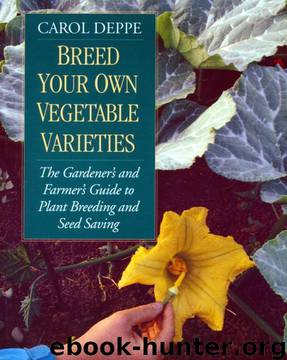Breed Your Own Vegetable Varieties: The Gardener's & Farmer's Guide to Plant Breeding & Seed Saving by Carol Deppe

Author:Carol Deppe [Deppe, Carol]
Language: eng
Format: epub, pdf
Published: 2011-05-29T01:55:00+00:00
When I first started playing with wild-collected dandelions, I treated them exactly as if they were a typical domesticated crop. Our normal garden crops are imported from elsewhere, and we usually grow them by altering our conditions to make them as much as possible like those where the vegetables originated. I did not realize the agroecological implications of working with a plant that was already perfectly adapted to growing in my area. I now view the agroecological implications as one of the most important reasons for collecting and cultivating wild edibles.
Dandelions growing wild in my region have been selected to be able to survive summer drought and to do their growing in the wet winter and spring. That means that they could make a nice permanent bed of edible and ornamental that would require no water and no care. Dandelions that grow wild in your area will probably have different characteristics. If you live in an area with severe winters, for example, your wild dandelions might make especially big roots and then die back and go dormant in winter. Such a dandelion might put on a heavy burst of leaves in early spring. Or it might have potential as a forcing crop - a vegetable that produces a root that is harvested and then put in a warm place to develop a crop of greens during the winter.
My dandelion might not be able to go dormant in winter and may not even survive in a harsher winter. Then again, the ability to go dormant whenever there is a reason to may be one of the basic characteristics of all dandelions. This seems to be the case with sea kale (Crambe maritima). It can go dormant in either winter or, because you forgot to water it, summer. It doesn't go dormant if you water it in summer. Allium vineale, a local naturalized wild onion or garlic, represents the other extreme. It goes dormant and dies back in summer whether it is watered or not.
Working with native edibles broadens your perspective on gardening. It invites you to reexamine all your gardening methods and how they fit into your life-style, your cultural
patterns, your cooking and eating habits, and the ecology of your region. It helps you identify the underlying assumptions and imagine other possibilities.
We need native vegetables. But we need more than just the plants. We also need entirely different ways of growing and using them, ways that capitalize on their unique adaptation to our climate and their special properties.
Download
Breed Your Own Vegetable Varieties: The Gardener's & Farmer's Guide to Plant Breeding & Seed Saving by Carol Deppe.pdf
This site does not store any files on its server. We only index and link to content provided by other sites. Please contact the content providers to delete copyright contents if any and email us, we'll remove relevant links or contents immediately.
Turbulence by E. J. Noyes(7935)
The Thirst by Nesbo Jo(6826)
Gerald's Game by Stephen King(4570)
Be in a Treehouse by Pete Nelson(3939)
Marijuana Grower's Handbook by Ed Rosenthal(3619)
The Sprouting Book by Ann Wigmore(3543)
The Red Files by Lee Winter(3366)
The Remains of the Day by Kazuo Ishiguro(3291)
Sharp Objects: A Novel by Gillian Flynn(2952)
Christian (The Protectors Book 1) by L. Ann Marie(2653)
Organic Mushroom Farming and Mycoremediation by Tradd Cotter(2626)
The Culinary Herbal by Susan Belsinger(2429)
Stone Building by Kevin Gardner(2347)
The Starter Garden Handbook by Alice Mary Alvrez(2281)
Lilac Girls by Martha Hall Kelly(2256)
The Unlikely Pilgrimage of Harold Fry by Rachel Joyce(2215)
The Lean Farm Guide to Growing Vegetables: More In-Depth Lean Techniques for Efficient Organic Production by Ben Hartman(2096)
Urban Farming by Thomas Fox(2061)
Backyard Woodland by Josh VanBrakle(1892)
